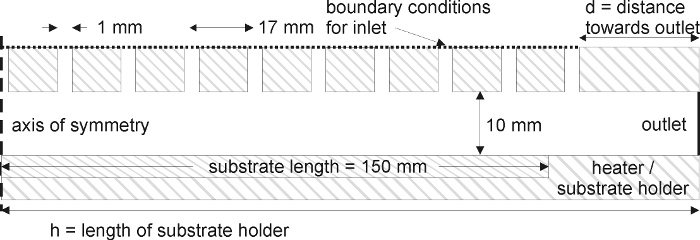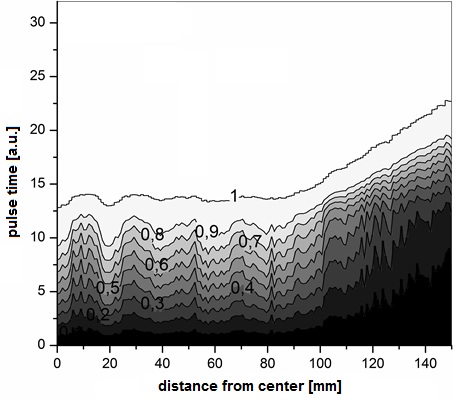Atomic Layer Deposition - ALD
Introduction
Atomic layer deposition (ALD) is a technique which relies on alternating, self limiting surface reactions. The ALD process is conducted in a vacuum chamber (reactor) at a pressure of about 100 Pa. The reactor is purged by an inert gas between the alternating surface reactions. Most processes employ two gaseous chemicals which are introduced into the ALD reactor seperately.
An ideal ALD process has two unique features which arrise from the self limiting nature of the surface reactions. First of all, the film thickness can be controlled on an atomic level. Second, the deosited films are perfectly uniform. The most prominent application of ALD is the deposition of dielectrics in memory chips. The substrates are currently silicon wafers with a diameter of 300 mm. The structures the film is deposited on are of the size of 50 - 100 nano meters. In order to build a fast and effective reactor, PI-DSMC can be used to study the gasflow in an ALD reactor.
What are the properties that can be used to rate an ALD reactor? The following properties can be defined and quantified with a DSMC calculation:
- Geometric efficiency - the fraction of molecules that interacts with the substrate
- Process efficiency - the fraction of molecules that is adsorbed by the substrate during a single self limiting surface reaction
- Gas exchange time - the average time a gas molecule remains within the reactor
- Pressure distribution - the distribution of the pressure along the substrate surface
Example
The image below shows the cross section of a typical ALD reactor.
The dotted line to the left is the axis of rotational symmetry.
The gas enters the reactor through the inlets at the top of the reactor.
The outlet is connected to a pump. Therefore, molecules hitting the outlet are removed.
The walls at the top of the reactor have a temperature of 150 °C while the substrate has a temperature of 300 °C.

The gas flow is described by distribution functions that are determined by DSMC.
The adsorption of precursor molecules by the substrate and the structure of the substrate is taken into account by a complex surface model.
With the statistical description of the gas flow and the surface model it is possible to simulate the whole ALD process.
The image below shows the evolution of the surface saturation with pulse time. The sticking coefficient in this example is 1.
Therefore, the structure of the inlet is visible in the saturation profile.
The time required for complete saturation increases towards the outlet as the pressure drops.

The method can be used to study the impact of different reactor geometries, surface geometries, process conditions and different sticking coefficients on the process efficiency.
The results of this work are described in greater detail in my PhD thesis. Please, let me know if you're interested in the details of this work.